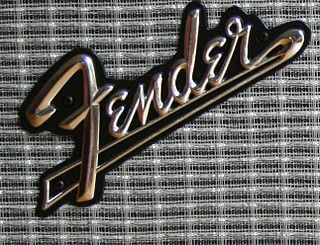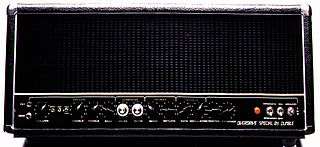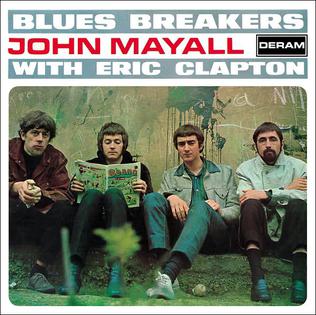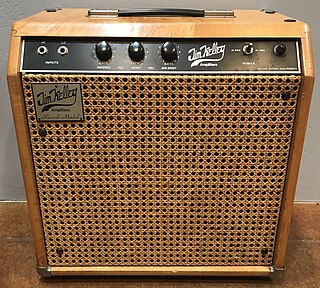Related Research Articles

A guitar amplifier is an electronic device or system that strengthens the weak electrical signal from a pickup on an electric guitar, bass guitar, or acoustic guitar so that it can produce sound through one or more loudspeakers, which are typically housed in a wooden cabinet. A guitar amplifier may be a standalone wood or metal cabinet that contains only the power amplifier circuits, requiring the use of a separate speaker cabinet–or it may be a "combo" amplifier, which contains both the amplifier and one or more speakers in a wooden cabinet. There is a wide range of sizes and power ratings for guitar amplifiers, from small, lightweight "practice amplifiers" with a single 6" speaker and a 10 watt amp to heavy combo amps with four 10” or four 12" speakers and a powerful 100 watt amplifier, which are loud enough to use in a nightclub or bar performance.

Marshall Amplification is a British company that designs and manufactures music amplifiers, speaker cabinets, brands personal headphones and earphones, a record label and, having acquired Natal Drums, drums and bongos. It was founded by drum shop owner and drummer Jim Marshall, and is now based in Bletchley, Milton Keynes, Buckinghamshire.

Fender amplifiers are a series of electric instrument amplifiers renowned by musicians worldwide. The Fender Musical Instruments Corporation has continuously manufactured guitar amplifiers since their foundation, Leo Fender began building guitar amplifiers before he started manufacturing electric guitars. The first of these were the K&F models, produced between 1945 and 1946. Fender amplifiers would become favourites of many famous guitarists such as Stevie Ray Vaughan, Jimi Hendrix and Eric Clapton, helping them pioneer their sounds.

Dumble is a guitar amplifier manufacturer in Los Angeles, California.

Blues Breakers with Eric Clapton, colloquially known as The Beano Album, is a studio album by the English blues rock band John Mayall and the Bluesbreakers. Produced by Mike Vernon and released in 1966 by Decca Records (UK) and London Records (US), it pioneered a guitar-dominated blues-rock sound.

The Echoplex is a tape delay effect, first made in 1959. Designed by Mike Battle, the Echoplex set a standard for the effect in the 1960s—it is still regarded as "the standard by which everything else is measured." It was used by some of the most notable guitar players of the era; original Echoplexes are highly sought after.

The Fender Twin and Twin Reverb are guitar amplifiers made by Fender Musical Instruments Corporation. The Twin was introduced in 1952, two years before Fender began selling Stratocaster electric guitars. The amps are known for their characteristically clean tone.
This is a history of the equipment that the English rock band The Who used. It also notes their influence on the instruments of the time period.

The Fender Bassman is a bass amplifier series introduced by Fender during 1952. Initially intended to amplify bass guitars, the 5B6 Bassman was used by musicians for other instrument amplification, including the electric guitar, harmonica, and pedal steel guitars. Besides being a popular and important amplifier in its own right, the Bassman also became the foundation on which Marshall and other companies built their high-gain tube amplifiers.
The Marshall Super Lead Model 1959 is a guitar amplifier head made by Marshall. One of the famous Marshall Plexis, it was introduced in 1965 and with its associated 4×12″ cabinets gave rise to the "Marshall stack".
This is a list and description of the guitars and other equipment played by musician Stevie Ray Vaughan. Vaughan played a number of Fender Stratocasters throughout his career, one of which, a 1963 body and a late 1962 rosewood neck, became "the most famous battered Strat in rock history." He was notoriously hard on his guitars, and many of them required extensive periodic maintenance, as well as other equipment. He used a limited number of effect pedals, and favored Fender and Marshall amplification.

Jim Kelley Amplifiers is the trademark for the vacuum tube guitar amplifiers designed by Jim Kelley and manufactured by his company Active Guitar Electronics of Tustin, California between the years of 1978 and 1985. Approximately 600 of these amps were built during that time. The single-channel version of the amplifier employed modest gain in the preamp stages, Baxandall type bass and treble controls, a split load phase inverter, and four 6V6GT output tubes. The amplifiers produce 60 watts RMS at full power, and include a half power (30/60) switch.
This is some of the musical equipment used by the members of the hard rock/blues rock band ZZ Top.

The Marshall JTM45 is the first guitar amplifier made by Marshall. First produced in 1963, it has been called a "seminal" amplifier, and is praised as the most desirable of all the company's amplifiers.
The JCM800 series is a line of guitar amplifiers made by Marshall Amplification. The series was introduced in 1981. Although models 1959 and 1987 had been in production since 1965 and the 2203 and 2204 had been in production since 1975, they were redesigned and introduced as JCM800 amplifiers in '81. The JCM800 amplifiers became a staple of 1980s hard rock and heavy metal bands.
Trainwreck Circuits is an American company that manufactures boutique guitar amplifiers. The company was founded by Ken Fischer in 1985. Trainwreck amplifiers are made in Colonia, New Jersey and are among the most sought-after amplifiers on the market.
The EchoSonic is a guitar amplifier made by Ray Butts. It was the first portable guitar amplifier with a built-in tape echo effect, and it allowed guitar players to use slapback echo, which dominated 1950s rock and roll guitar playing, on stage. He built the first one in 1953 and sold the second one to Chet Atkins in 1954. He built fewer than seventy of those amplifiers; one of them was bought by Sam Phillips and then used by Scotty Moore on every recording he made with Elvis Presley, from the 1955 hit song "Mystery Train" to the 1968 TV program Comeback Special. Deke Dickerson called the amplifier the Holy Grail of rockabilly music.

Fuzz bass, also called "bass overdrive" or "bass distortion", is a style of playing the electric bass or modifying its signal that produces a buzzy, distorted, overdriven sound, which the name implies in an onomatopoetic fashion. Overdriving a bass signal significantly changes the timbre, adds higher overtones (harmonics), increases the sustain, and, if the gain is turned up high enough, creates a "breaking up" sound characterized by a growling, buzzy tone.

Vintage musical equipment is older music gear, including instruments, amplifiers and speakers, sound recording equipment and effects pedals, sought after, maintained and used by record producers, audio engineers and musicians who are interested in historical music genres. While any piece of equipment of sufficient age can be considered vintage, in the 2010s the term is typically applied to instruments and gear from the 1970s and earlier. Guitars, amps, pedals, electric keyboards, sound recording equipment from the 1950s to 1970s are particularly sought. Musical equipment from the 1940s and prior eras is often expensive, and sought out mainly by museums or collectors.
The Dallas Rangemaster Treble Booster was an effects unit made for guitarists in the 1960s. Its function was two-fold: to increase the signal strength of the guitar going into the amplifier, and to increase tones at the high end of the spectrum.
References
- 1 2 3 4 5 6 7 8 Pittman, Aspen (2003). The Tube Amp Book. Hal Leonard. pp. 66, 69–70. ISBN 978-0-87930-767-7.
- 1 2 3 Lawrence, Robb (2008). The Early Years of the Les Paul Legacy: 1915–1963. Hal Leonard. pp. 248–49. ISBN 978-0-634-04861-6.
- ↑ Grant, Tina (2004). International directory of company histories: Volume 62. St. James. pp. 240–41. ISBN 978-1-55862-507-5.
- ↑ Trynka, Paul (1996). Rock hardware. Hal Leonard. p. 19. ISBN 978-0-87930-428-7.
- ↑ Hughes, Tom (September 2007). "Myth Busters, Stomp School Edition". Premier Guitar . Archived from the original on 2 October 2012. Retrieved 11 April 2011.
- ↑ Maloof, Rich (2004). Jim Marshall, Father of Loud: The Story of the Man Behind the World's Most Famous Guitar Amplifiers . Hal Leonard. pp. 48–49. ISBN 978-0-87930-803-2.
- 1 2 3 4 5 6 7 Doyle, Michael (1993). The history of Marshall: the illustrated story of "the sound of rock". Hal Leonard. pp. 23–25. ISBN 978-0-7935-2509-6.
- ↑ Marshall, Wolf (2008). Stuff! Good Guitar Players Should Know: An A-Z Guide to Getting Better. Hal Leonard. p. 25. ISBN 978-1-4234-3008-7.
- ↑ Hunter, Dave (June 2011). "25 Most Valuable Amplifiers". Vintage Guitar . pp. 38–40.
- ↑ Wiley, John (February 2008). "The BluesBreaker Revisited". Premier Guitar . Archived from the original on 13 December 2010. Retrieved 11 April 2011.
- ↑ Hunter, Dave (2004). Guitar effects pedals: the practical handbook. Hal Leonard. ISBN 978-0-87930-806-3.
- ↑ "1962 Bluesbreaker: Specifications". Marshall Amps. Retrieved 11 April 2011.
- ↑ Childs, Zac (October 2014). "Bluesbreaker Redux: Marshall Handwired Series 2245THW head and 1960AHW Cabinet". Vintage Guitar . p. 130.
- ↑ Weber, Gerald (1997). Tube Amp Talk for the Guitarist and Tech. Hal Leonard. pp. 135–37. ISBN 978-0-9641060-1-7.
- 1 2 Hunter, Dave (2005). Guitar Rigs: Classic Guitar & Amp Combinations. Hal Leonard. pp. 111–12. ISBN 978-0-87930-851-3.
- ↑ Cope, Andrew L. (2010). Black Sabbath and the rise of heavy metal music. Ashgate. p. 16. ISBN 978-0-7546-6881-7.
- ↑ Shapiro, Harry (May 2018). "John Mayall's Bluesbreakers with Eric Clapton: The Making of 'the Beano album'". Classic Rock . Retrieved 23 September 2020.
- ↑ Weber, Gerald (1997). Tube Amp Talk for the Guitarist and Tech. Hal Leonard. p. 412. ISBN 978-0-9641060-1-7.